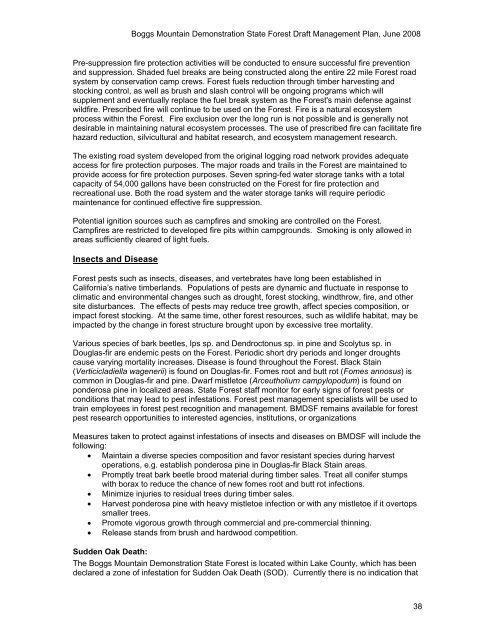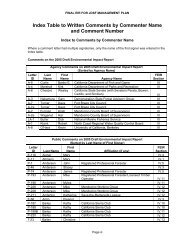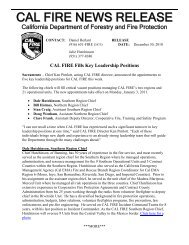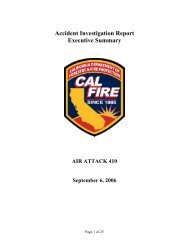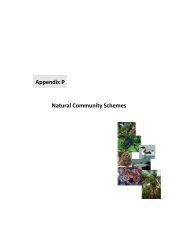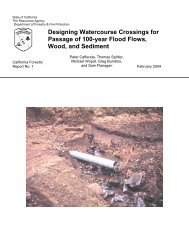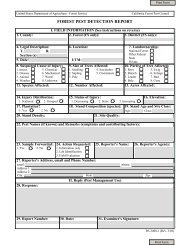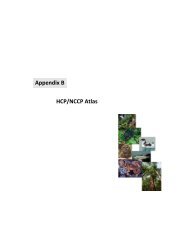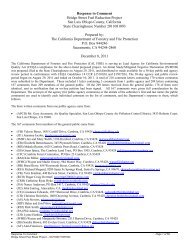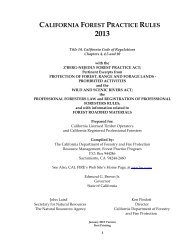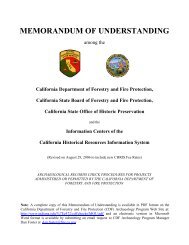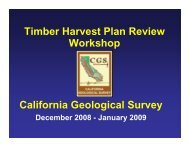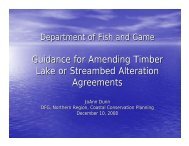Boggs Mountain Demonstration State Forest Draft ... - Cal Fire
Boggs Mountain Demonstration State Forest Draft ... - Cal Fire
Boggs Mountain Demonstration State Forest Draft ... - Cal Fire
You also want an ePaper? Increase the reach of your titles
YUMPU automatically turns print PDFs into web optimized ePapers that Google loves.
<strong>Boggs</strong> <strong>Mountain</strong> <strong>Demonstration</strong> <strong>State</strong> <strong>Forest</strong> <strong>Draft</strong> Management Plan, June 2008<br />
Pre-suppression fire protection activities will be conducted to ensure successful fire prevention<br />
and suppression. Shaded fuel breaks are being constructed along the entire 22 mile <strong>Forest</strong> road<br />
system by conservation camp crews. <strong>Forest</strong> fuels reduction through timber harvesting and<br />
stocking control, as well as brush and slash control will be ongoing programs which will<br />
supplement and eventually replace the fuel break system as the <strong>Forest</strong>'s main defense against<br />
wildfire. Prescribed fire will continue to be used on the <strong>Forest</strong>. <strong>Fire</strong> is a natural ecosystem<br />
process within the <strong>Forest</strong>. <strong>Fire</strong> exclusion over the long run is not possible and is generally not<br />
desirable in maintaining natural ecosystem processes. The use of prescribed fire can facilitate fire<br />
hazard reduction, silvicultural and habitat research, and ecosystem management research.<br />
The existing road system developed from the original logging road network provides adequate<br />
access for fire protection purposes. The major roads and trails in the <strong>Forest</strong> are maintained to<br />
provide access for fire protection purposes. Seven spring-fed water storage tanks with a total<br />
capacity of 54,000 gallons have been constructed on the <strong>Forest</strong> for fire protection and<br />
recreational use. Both the road system and the water storage tanks will require periodic<br />
maintenance for continued effective fire suppression.<br />
Potential ignition sources such as campfires and smoking are controlled on the <strong>Forest</strong>.<br />
Campfires are restricted to developed fire pits within campgrounds. Smoking is only allowed in<br />
areas sufficiently cleared of light fuels.<br />
Insects and Disease<br />
<strong>Forest</strong> pests such as insects, diseases, and vertebrates have long been established in<br />
<strong>Cal</strong>ifornia’s native timberlands. Populations of pests are dynamic and fluctuate in response to<br />
climatic and environmental changes such as drought, forest stocking, windthrow, fire, and other<br />
site disturbances. The effects of pests may reduce tree growth, affect species composition, or<br />
impact forest stocking. At the same time, other forest resources, such as wildlife habitat, may be<br />
impacted by the change in forest structure brought upon by excessive tree mortality.<br />
Various species of bark beetles, Ips sp. and Dendroctonus sp. in pine and Scolytus sp. in<br />
Douglas-fir are endemic pests on the <strong>Forest</strong>. Periodic short dry periods and longer droughts<br />
cause varying mortality increases. Disease is found throughout the <strong>Forest</strong>. Black Stain<br />
(Verticicladiella wagenerii) is found on Douglas-fir. Fomes root and butt rot (Fomes annosus) is<br />
common in Douglas-fir and pine. Dwarf mistletoe (Arceutholiurn campylopodum) is found on<br />
ponderosa pine in localized areas. <strong>State</strong> <strong>Forest</strong> staff monitor for early signs of forest pests or<br />
conditions that may lead to pest infestations. <strong>Forest</strong> pest management specialists will be used to<br />
train employees in forest pest recognition and management. BMDSF remains available for forest<br />
pest research opportunities to interested agencies, institutions, or organizations<br />
Measures taken to protect against infestations of insects and diseases on BMDSF will include the<br />
following:<br />
• Maintain a diverse species composition and favor resistant species during harvest<br />
operations, e.g. establish ponderosa pine in Douglas-fir Black Stain areas.<br />
• Promptly treat bark beetle brood material during timber sales. Treat all conifer stumps<br />
with borax to reduce the chance of new fomes root and butt rot infections.<br />
• Minimize injuries to residual trees during timber sales.<br />
• Harvest ponderosa pine with heavy mistletoe infection or with any mistletoe if it overtops<br />
smaller trees.<br />
• Promote vigorous growth through commercial and pre-commercial thinning.<br />
• Release stands from brush and hardwood competition.<br />
Sudden Oak Death:<br />
The <strong>Boggs</strong> <strong>Mountain</strong> <strong>Demonstration</strong> <strong>State</strong> <strong>Forest</strong> is located within Lake County, which has been<br />
declared a zone of infestation for Sudden Oak Death (SOD). Currently there is no indication that<br />
38


